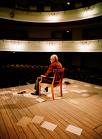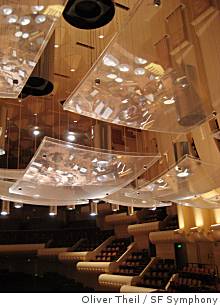
Composing For Silent Films
 One art form which is en vogue at the moment in the Bay Area and elsewhere is the practice of composing and performing new musical scores to accompany silent films.
One art form which is en vogue at the moment in the Bay Area and elsewhere is the practice of composing and performing new musical scores to accompany silent films.
One of the highlights of the annual SF International Film Festival is its combination of live rock music and silent film at the Castro Theatre. Recent years have witnessed pairings between Deerhoof and Harry Smith’s Heaven and Earth Magic, Lambchop and Murnau’s Sunrise, Yo La Tengo and Jean Painlevé’s wildlife films, and, last year, Dengue Fever performing the world premiere of their newly composed score for Harry Hoyt’s 1925 dinosaur epic The Lost World. Meanwhile, local composers like Jill Tracy write and perform luxuriant noirish scores at cinemas all over the Bay Area.
Because silent film has no dialogue or other sound, the musical score has the potential to stand out much more clearly than in a talkie, which gives composers much more creative leeway in some ways. Yet writing music for this medium has its challenges. The composer must take care not to usurp the pictures with his or her soundscape. He or she can underscore the mood of a scene or perhaps even undercut it if going for a special effect. But the music should always be in service of the images and shouldn’t guide audience members emotions in ways that don’t fit with the film. Because the filmmakers of these early films are mostly long dead by now, keeping all these elements in check is difficult — the creator of the movie isn’t around to consult with about mood, intention, and other qualities visible on screen.
Last night’s San Francisco Film Festival event, Music for Silents, showed how composing for early film can be done well. Musician Steven Severin, co-founder of the 70s British punk band Siouxie and the Banshees and, more recently, a film composer, presented his original score for The Seashell and the Clergyman (1928), a French Surrealist fantasy directed by Germaine Dulac and written by Antonin Artaud.
The film’s plot, if it can be said to have one at all, is obscure. The story seems to revolve around a randy Catholic priest whose obsession with women leads him to behave erratically. He rips off a female character’s bustier and strangles a fellow priest, among other things. It’s no wonder that the British Board of Film Censors called the film blasphemous and banned it.
Severin’s electronic score thrums with life throughout the 35-minute film. The pulsations draw us into ourselves. Our breathing slows and before long we find ourselves occupying the same psychological space as the characters. The low church organ-like rumbles suggest the religious landscape of the story. Meanwhile, some fast, scattered phrases create a flighty, bird-like energy. It’s as if the music is mimicking the rapid heartbeat of the priest.
The combination of music and visuals reminded me strongly of the Cremaster films of Matthew Barney, owing to the mixture of cold, sepulchral stasis in the composition of some of the images and throbbing score and larger-than-life emotions.
The New Old Cabaret

Yet there do seem to be a few performers out there who are interested in keeping the flame of traditional cabaret alive. One such performer is Carly Ozard, a young San Francisco-based chanteuse whom I heard for the first time at the Eureka Theatre over the weekend and was blown away by.
Ozard has been performing on the local scene for a while with such musical theater and light opera companies as the Lamplighters and 42nd Street Moon. I’ve heard her perform in these contexts before. But I had little idea about what a great singer and communicator she was until I experienced her solo act on stage.
Ozard’s songlist followed the standard pattern of vacillating from serious to comic to serious to comic songs. Yet there was enough variety in the performance to keep us engaged. Ozard’s playlist betrayed a wicked, self-deprecating sense of humor as well as a soft and cuddly side which was tender but never sugary. Her repertoire was smart, full of personality and eclectic with numbers ranging from “Closer to Fine” by Emily Sailers of The Indigo Girls, to a side-splitting bastardization of the Rogers and Hart classic “Bewitched, Bothered and Bewildered”. Ozard’s version, entitled “Bewitched, Bothered and Bipolar” and adapted by local impresario Tom Orr, was one of the highlights of the show.
Ozard was sick the night she performed at The Eureka Theatre, but she remained the consummate professional throughout. There’s a toughness about her which is sassy and likable. “My teacher says that it doesn’t look right to drink water out of a bottle on stage,” Ozard said at one point, taking slugs from a big plastic bottle. “Well, that’s too bad.” She also has a natural banter and managed to link the songs with funny and touching anecdotes which moved the show along without getting in the way of the music. In other words, she managed to maintain a good balance between songs and talk.
It’s no surprise that Ozard was named Best Cabaret Performer at the Cabaret Showcase Showdown 2009. I predict this performer will go far.
Jubilation
 I’m constantly struck by the ways in which music, more than any other artform, is capable of stirring up deep personal memories. It’s also interesting to see how those memories mutate over time.
I’m constantly struck by the ways in which music, more than any other artform, is capable of stirring up deep personal memories. It’s also interesting to see how those memories mutate over time.
I as reminded of this once again over the weekend at a San Francisco Symphony concert featuring two works by the British composer George Benjamin who is currently in residency at the Symphony. The conductor was David Robertson.
One of my most powerful memories as a youngster was singing in Jubilation, a piece written by the Benjamin in 1985 for orchestra and children’s choir. My school choir joined forces with ensembles from other local schools to sing in the piece. We performed the work in Canterbury Cathedral with the composer conducting. I was about 11 at the time and have vivid recollections of standing amid what seemed like a vast army of children belting out Benjamin’s sustained notes to syllables from the solfege system — “mi, re, so fah, doh!” I was terrified of missing the high C at the climax of the piece. Our teacher worked with us for weeks on trying to hit that note in tune. When we performed the piece, the sound, at least as it has reverberated in my mind across the intervening decades, was nothing short of cataclysmic.
So it was a real treat, and a slight disappointment, to hear the piece performed again on Friday. The choir was from one of the local music-oriented schools, The Crowden School. But it was much smaller in size than the ensemble I had sung with in the 80s. As a result, even though the singing was lovely — and the instrumental and harmonic nuances of Benjamin’s intricate score rang clearly — the piece came across without as much force as it should have. Jubilation sounded more apologetic than jubilant. I don’t know whether my memory had inflated the piece of music to a more imposing size than it really was, or whether it genuinely lacked the power I recalled.
Backstage after the concert, I went to say hello to the composer. Looking dapper but casual in beige slacks, a pale blue shirt, a light brown jacket, brown shoes and a lemon yellow tie with his close-cropped white hair sweeping back from his round, boyish face, Benjamin looked more like a self-effacing community college professor than a widely respected composer being celebrated by a major symphony orchestra. Benjamin seemed happy to hear about my experience of singing his piece way back when. I was surprised to hear that Jubilation has only received a couple of other performances since it was written. The composer didn’t seem to mind the smaller choir in SF Symphony’s performance — “they did a good job,” he generously said (his voice is soft, high-pitched and sing-songy). I got the impression that he thought the piece worked just as fine with a small choir as a big one. But perhaps he was just being kind.
Then we shook hands and he went off down the hall to meet composer John Adams, who was waiting for him with his coat over his arm and a bright red scarf around his neck.
Symphony Acoustic Panels Explained
 I’ve always wondered about the futuristic-looking convex panels in Davies Symphony Hall that glide up and down during performances to hone the acoustics of the auditorium.
I’ve always wondered about the futuristic-looking convex panels in Davies Symphony Hall that glide up and down during performances to hone the acoustics of the auditorium.
The San Francisco Chronicle’s Joshua Kosman answered most of my questions in his short yet eloquent piece about the panels in yesterday’s paper.
On Vanishing Drag Queens

 San Francisco’s nooks and crannies are full of unusual and often beautifully-rendered bits of street art. The trouble is, even the loveliest bits don’t seem to have a long shelf life.
San Francisco’s nooks and crannies are full of unusual and often beautifully-rendered bits of street art. The trouble is, even the loveliest bits don’t seem to have a long shelf life.
Around Thanksgiving last year, a makeshift ply-board wall around a building site on Market Street near Octavia Boulevard caught my eye with its detailed and colorful rendering of six drag queens. I took a picture of it with my iPhone. (See image on the left). The New York Times published the picture on its Bay Area blog page and readers were asked to identify the drag queens depicted by the mystery artist’s hand.
Less than a couple of months have passed since I took the picture and the drag queens have disappeared from view. (See image on right, which I took this morning.) You can just about make out a bit of Dame Edna’s pink coiff in the top left hand corner of the second image, but otherwise it’s as if the drag queens had never existed on that wall. I don’t know whether someone scratched them out on purpose or whether they just weathered away. I’m guessing the former because it would probably take more than a few weeks for the graffiti to disappear.
I’m sad about it. Those drag queens brightened up an otherwise ugly building site. They made me smile when I passed them, which I did nearly every day. That’s the nature of street art though: here today, gone tomorrow. That’s one thing that makes street art like theatre.
At least San Francisco artists are constantly creating new, eye-catching works on our local walls. Here’s a beautiful rendering by a mystery painter who initials his or her work “TS”. The word painted on the bottom in blue type (illegible in this photograph) is “clairvoyance.” I wonder what the artist is trying to say here? Maybe he or she knows that it won’t be long before this bespectacled, bearded gent, like the drag queens, will disappear.
Should The Same Rules Apply?
 Should the rules that apply to one genre of music apply to another?
Should the rules that apply to one genre of music apply to another?
This question popped into my mind last night in the wake of two very contrasting vocal music experiences
I spent the first part of the evening at the KALW radio studios in San Francisco recording a VoiceBox show with jazz and blues singer and jazz historian Kim Nalley about Ella Fitzgerald’s voice. Critics are pretty much unanimous in praising Ella for her crystal clear diction, spot-on intonation and careening range. Every song we played during the hour-long recording session for the show substantiated these aspects of the singer’s voice.
Later on that evening, I went to The Bottom of the Hill, a music club in the Potrero Hill neighborhood of San Francisco to hear a couple of new bands — Hey Young Believer and Blood and Sunshine. The members of these electronic indie rock groups, are — at a guess — all in their early to mid-20s — in other words, a bit older than Ella was when she started out.
The musicianship, as far as instrumental beats and riffs go, was lively. Both groups created thick, woven textures with their synthesizers, drums and guitars. But the vocal lines were just about the weakest aspect of the music I heard. I could barely make out a single word the singers were uttering and the voices were raspy, limited in range and flexibility, often out of tune and lacking in support. I wasn’t super impressed with either group.
Of course, the singers in some of my favorite bands right now, such as Florence and the Machine and Radiohead, make a habit of poor diction. Somehow this shortcoming matters less, though — perhaps because the voices have such an extraordinary or unusual timbre, superlative range and are always in tune.
I’m not saying every singer should aim to sound like Ella Fitzgerald. But paying attention to the basics, such as diaphragmatic support and tuning, should probably be a foundation for all singers across all genres.
SF Comedy Is Alive And Well

But I am pleased to report that the scene may be coming back to life. I’ve been getting inklings of this rebirth every now and again. But on new year’s eve, thanks to a lineup of comedians arranged by impresario Jill Bourque (pictured), I finally came to the conclusion that the comedy scene is really taking off again in this part of the world.
Bourque’s “Not Your Normal NYE” event at The Herbst Theatre (a venue usually reserved for chamber music concerts and lecture series) featured a wonderful line up of genuinely off-beat comedic talent. I was familiar with some of the artists on the roster – such as Will Franken, Brent Weinbach and the We Are Nudes ensemble. I’ve been following Will’s career with interest for a while now and I’ve caught the Nudes a couple of times in recent months at the Climate Theater. Others on the roster, such as Loren Kraut, Mary Van Note, and Moshe Kasher, were new to me.
All of the acts were different and ranged from chortle-inducing to roll-in-the-aisles funny. I loved Moshe Kasher’s acidic delivery, Brent Weinbach’s slam-dunk punchlines, Mary Van Note’s ditzy and misplaced sexuality and Loren Kraut’s delicious nerdiness. We are Nudes play better in a more intimate space, but their act – which consists in part on an absurd, theatrical commentary on each other’s personalities and comedic chops — was still hilarious. Franken, a fervent experimenter, attempted too much audience participation shtick for my liking at Herbst. The audience wasn’t quite ready to go there with him and the lack of a follow-spot didn’t help his cause when he decided to descend from the stage and talk to a man sitting in the front row of the audience. But as a walking embodiment of multiple personality disorder on today’s comedy scene, the comedian still remains unparalleled.
The great thing about Bourque’s curatorial effort on new year’s eve was the combination of great diversity between the performers’ approaches and yet a strong unifying principle which may come to define the San Francisco comedy scene as we enter the second decade of the 21st century. This unifying principle is unconventionality. Not one of the performers simply stood on stage and told jokes. But all of them possessed a madcap absurdity touched with a dash of theatricality.
On Listening Without Cringing
 Many creative people don’t feel comfortable about attending performances of their own work. I’m not sure why reliving this experience makes them feel awkward. Does it have something to do with embarrassment at being the center of attention? Or perhaps a fear that people won’t respond positively?
Many creative people don’t feel comfortable about attending performances of their own work. I’m not sure why reliving this experience makes them feel awkward. Does it have something to do with embarrassment at being the center of attention? Or perhaps a fear that people won’t respond positively?
I got a small taste of this feeling last week as the inaugural broadcast of my new public radio show all about the art of singing, VoiceBox, loomed closer. The series, which runs every Friday evening from 10pm-11pm Pacific Time, launched on New Year’s day. I hadn’t ever listened to any of the five pilot broadcasts which aired last summer; somehow I just couldn’t bring myself to.
But the journey between then and the official launch last week was such a momentous one for me (as a result of all the thinking, fundraising and other activities involved in starting a new project of this sort) that I felt I needed to not only listen in to the show, but also to mark the occasion somehow.
So it was with a combined mixture of mild reluctance, tremendous excitement and a big dollop of fear, that I invited a bunch of friends over on Friday evening for an impromptu VoiceBox listening party.
Girded by cheese and crackers, homemade brownies and prosecco cocktails, the event went rather well. One friend remarked about how sweetly old-fashioned it was to huddle around the wireless listening to a show with a group of people (well, we huddled around my laptop, but the effect was much the same as sitting in front of a radio in the pre-television era.) People seemed to respond positively. For my part, I managed to get through the hourlong broadcast without cringing too much.
And I was glad I listened, as I learned a lot from putting myself through the recording. Some aspects could use improvement: There were times when I sounded too much like I was reading. I need to work on sounding a little less canned. Other aspects of the show, I quite enjoyed. The mad, eclectic playlist made me happy, as did the fact that I didn’t sound rushed.
I don’t know how often I’ll get to listen to the show “live” in the coming weeks — my arts reviewing schedule will very likely prevent it — but I should probably make a point of tuning in after the fact from here on in. Listening to one’s own creative efforts isn’t the most comfortable experience in the world, but you can learn a lot from doing so.
VoiceBox Launches Tonight!
 Calling all lovers of vocal music!
Calling all lovers of vocal music!
VoiceBox, a new public radio series which I am producing and hosting on behalf of NPR-affiliated station KALW 91.7 FM, is launching tonight!
VoiceBox kicks off on KALW 91.7 FM San Francisco at 10pm Pacific Time with a show entitled “why we sing.” The first official program in the new series all about exploring the art of song, “why we sing” examines the basic impulses underpinning human beings’ apparent yen for bursting into song and features a very eclectic playlist including tracks by duetting gibbons, Inuit throat singers, the San Francisco Gay Men’s Chorus, Sting, Anonymous 4 and many others. There’s even a montage of Bay Area people singing in the shower which is absolutely not to be missed.
If you’d like to listen, please tune in tonight at 10pm PST via the dial or via live webstream at www.kalw.org. I also plan to have the recording of the show on the VoiceBox website before too long, so if you miss it tonight, you’ll be able to catch it there. Short podcasts packed with news and music excerpts will also be coming soon to further enrich your VoiceBox listening experience.
In other, but not unrelated news: I am soliciting input for the January 15 show, which is all about community choirs. (January 8 is devoted to exploring the voice of the one and only Ella Fitzgerald with a special guest, jazz and blues vocalist Kim Nalley.) If you sing in — or know of — fabulous community (ie non-professional) vocal ensembles both in the Bay Area and elsewhere including abroad, please get in touch. Even better: please email me a couple of tracks of the group(s) for possible inclusion on the playlist for the show. I would need to receive all recordings by the end of the week – ie Friday Jan 8.
Finally, I am looking for editorial support to help take the VoiceBox website to the next level. If you know of any vocal music-savvy person with strong writing and editing skills who fancies donating a couple of hours of their week to a good and fun cause, please point them in my direction.
My Favorite Bay Area Theatrical Premieres 2009
 Here is a short list of my favorite local productions of new plays which had their world premieres in the Bay Area in 2009. The list is not in any particular order:
Here is a short list of my favorite local productions of new plays which had their world premieres in the Bay Area in 2009. The list is not in any particular order:
Faust, Part 1 by Mark Jackson, Shotgun Players
Legs and All by Summer Shapiro, Climate Theater
Rabbi Sam by Charlie Varon, The Marsh
This World in a Woman’s Hands by Marcus Gardley, Shotgun Players
Here’s to more great new theatrical productions in 2010!
Making It Pretty Doesn’t Pay (Well, Technically It Does, But Not In The Right Way)
![]() James Cameron’s massive CGI blockbuster epic, Avatar, is a gorgeous treat for the eyes. The lighting and water effects take digital animation to a new level of brilliance and delicacy. When you view the film in 3D, as I did a couple of days ago in a Chicago multiplex, you feel completely transported to a fantasy world. I don’t think I have ever seen such incandescent flora, sinewy fauna, and shimmering surfaces in an animated feature to date. The movie really does take the artform to a whole new visual level.
James Cameron’s massive CGI blockbuster epic, Avatar, is a gorgeous treat for the eyes. The lighting and water effects take digital animation to a new level of brilliance and delicacy. When you view the film in 3D, as I did a couple of days ago in a Chicago multiplex, you feel completely transported to a fantasy world. I don’t think I have ever seen such incandescent flora, sinewy fauna, and shimmering surfaces in an animated feature to date. The movie really does take the artform to a whole new visual level.
But as is so often the case with films of this ilk, producers throw money at special effects at the expense of the basics. While Avatar titillates the eyes, it addles the brain with its nonsensical, cliche-ridden plot, trite characters, and thinly-veiled, heavy-handed political morality.
The folks involved in making this film should learn a lesson or two from Pixar Animation Studios. Pixar’s filmmakers understand that unless you have the fundamentals of story in place, you will never have a great movie on your hands, no matter how wizard-like your special effects. Films like Ratatouille, Toy Story, and Up will endure and even become classics because of their unforgettable characters and clever writing. The animation supports these elements and brings them alive. The story is never in service to the special effects.
In Avatar, and many other CGI movies like it, the reverse is true. Ultimately, the movie will probably go down in history as no more than a footnote in the development of CGI technology.

